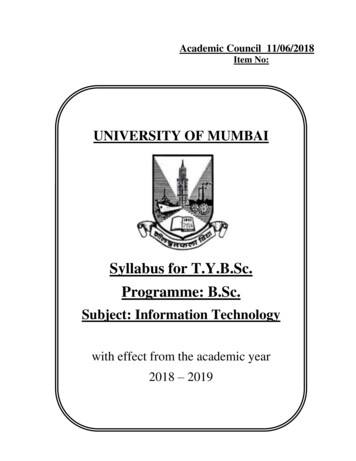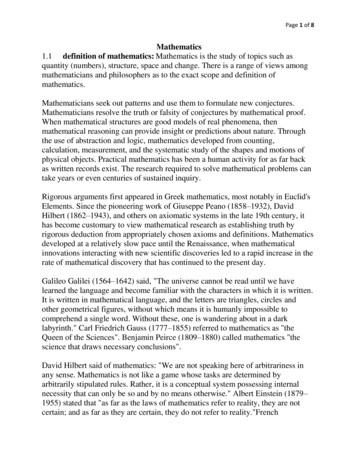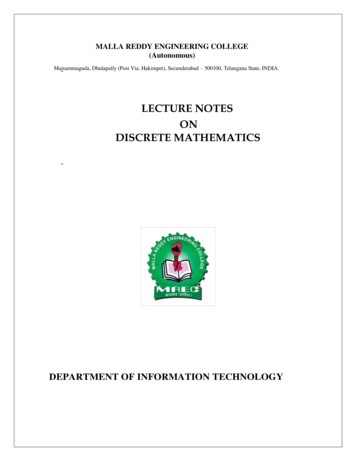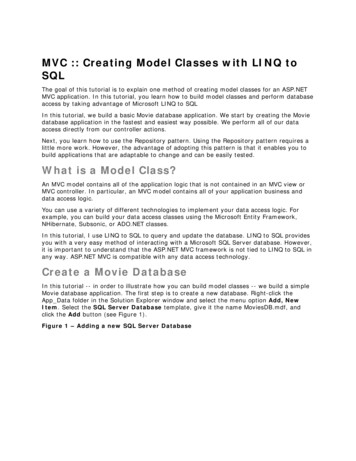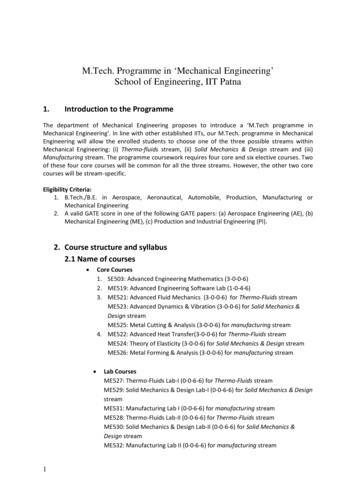
Transcription
GATE – SLPEC / EE / IN / CS / ME / CEEngineering MathematicsModule 1 : Linear Algebra, Calculus,Probability and StatisticsEdition : 0617/0619 800Copyright reserved with Vidyalankar Classes and Publications.All rights reserved. No part of this work herein should be reproduced or used eithergraphically, electronically, mechanically or by recording, photocopying, taping, webdistributing or by storing in any form and retrieving without the prior written permission ofthe publisher. Anybody violating this is liable to be legally prosecuted.Pearl Centre, S.B. Marg, Dadar (W), Mumbai 400 028.Tel. No. : 022 – 4232 4232 / 022 – 2430 63 67web site : www.vidyalankar.orge-mail : gate@vidyalankar.org
Dear GATE Aspirant,The GATE program will help you to overcome the common feeling of confusion about theexact scope of the syllabus. The course content will enable you to cover the coursesmoothly in the limited time at your disposal without wasting time on unnecessary details,without omitting any useful part.The program provides graded questions in every topic leading you to deeper and moreintricate and basic concepts. This will help you to stimulate your own thinking and alsomakes the process of learning, enjoyable and highly efficient.The quick methods suggested to tackle questions and the practice that one has to put inwhile solving the problems develops in you the required skill of tackling tricky problemsindependently and confidently. We are sure you will be in a position to deal with everyand any problem most successfully.I wish you all the best for your GATE.Thank YouRashmi DeshpandeDirectorVidyalankar Group of Educational Institutes
GATE SyllabusEngineering MathematicsElectronics & Communications (EC)Linear Algebra: Vector space, basis, linear dependence and independence, matrix algebra, eigen values and eigen vectors,rank, solution of linear equations – existence and uniqueness.Calculus: Mean value theorems, theorems of integral calculus, evaluation of definite and improper integrals, partial derivatives,maxima and minima, multiple integrals, line, surface and volume integrals, Taylor series.Probability and Statistics: Mean, median, mode and standard deviation; combinatorial probability, probability distributionfunctions - binomial, Poisson, exponential and normal; Joint and conditional probability; Correlation and regression analysis.Electrical Engineering (EE)Linear Algebra: Matrix Algebra, Systems of linear equations, Eigenvalues, Eigenvectors.Calculus: Mean value theorems, Theorems of integral calculus, Evaluation of definite and improper integrals, PartialDerivatives, Maxima and minima, Multiple integrals, Fourier series, Vector identities, Directional derivatives, Line integral,Surface integral, Volume integral, Stokes’s theorem, Gauss’s theorem, Green’s theorem.Probability and Statistics: Sampling theorems, Conditional probability, Mean, Median, Mode, Standard Deviation, Randomvariables, Discrete and Continuous distributions, Poisson distribution, Normal distribution, Binomial distribution, Correlationanalysis, Regression analysis.Instrumentation Engineering (IN)Linear Algebra: Matrix algebra, systems of linear equations, Eigen values and Eigen vectors.Calculus: Mean value theorems, theorems of integral calculus, partial derivatives, maxima and minima, multiple integrals,Fourier series, vector identities, line, surface and volume integrals, Stokes, Gauss and Green’s theorems.Probability and Statistics: Sampling theorems, conditional probability, mean, median, mode and standard deviation, randomvariables, discrete and continuous distributions: normal, Poisson and binomial distributions.Computer Science and Information Technology (CS)Linear Algebra: Matrices, determinants, system of linear equations, eigenvalues and eigenvectors, LU decomposition.Calculus: Limits, continuity and differentiability. Maxima and minima. Mean value theorem. Integration.Probability: Random variables. Uniform, normal, exponential, poisson and binomial distributions. Mean, median, mode andstandard deviation. Conditional probability and Bayes theorem.Mechanical Engineering (ME)Linear Algebra: Matrix algebra, systems of linear equations, eigenvalues and eigenvectors.Calculus: Functions of single variable, limit, continuity and differentiability, mean value theorems, indeterminate forms;evaluation of definite and improper integrals; double and triple integrals; partial derivatives, total derivative, Taylor series (in oneand two variables), maxima and minima, Fourier series; gradient, divergence and curl, vector identities, directional derivatives,line, surface and volume integrals, applications of Gauss, Stokes and Green’s theorems.Probability and Statistics: Definitions of probability, sampling theorems, conditional probability; mean, median, mode andstandard deviation; random variables, binomial, Poisson and normal distributions.Civil Engineering (CE)Linear Algebra: Matrix algebra; Systems of linear equations; Eigen values and Eigen vectors.Calculus: Functions of single variable; Limit, continuity and differentiability; Mean value theorems, local maxima and minima,Taylor and Maclaurin series; Evaluation of definite and indefinite integrals, application of definite integral to obtain area andvolume; Partial derivatives; Total derivative; Gradient, Divergence and Curl, Vector identities, Directional derivatives, Line,Surface and Volume integrals, Stokes, Gauss and Green’s theorems.Probability and Statistics: Definitions of probability and sampling theorems; Conditional probability; Discrete Randomvariables: Poisson and Binomial distributions; Continuous random variables: normal and exponential distributions; Descriptivestatistics - Mean, median, mode and standard deviation; Hypothesis testing.For EC/EE/IN/ME/CE : Topics in Vector Calculus are covered in different module.
Pearl Centre, S.B. Marg, Dadar (W), Mumbai 400 028.Tel. 4232 4232EC / EE / IN / CS / ME / CEENGINEERING MATHEMATICSMODULE 1INDEXContentsTopicsPageNo.Chapter 1 : Linear AlgebraNotesAssignmentsTest Papers1.1Determinants11.2Matrices41.3Rank of a Matrix121.4System of Linear Equations141.5Eigen Values and Eigen Vectors181.6Vectors21Assignment 124Assignment 227Assignment 330Assignment 434Assignment 537Assignment 640Assignment 743Assignment 846Assignment 948Assignment 1051Assignment 1154Test Paper 157Test Paper 260Test Paper 362Test Paper 464Test Paper 566Test Paper 668
ContentsTopicsPageNo.Chapter 2 : CalculusNotes2.1Function of single variable712.2Limit of a Mean Value Theorems792.6Maxima and Minima802.7Integration842.8Definite Integration932.9Double Integrals972.101042.12Triple IntegralsChange of Variables in Double and Triple Integralsand JacobiansApplication of Integration1112.13Partial and Total Derivatives1142.14Taylor's Series and Maclaurin's Series1212.15Fourier Series1232.11AssignmentsTest Papers106List of Formulae129Assignment 1134Assignment 2136Assignment 3138Assignment 4141Assignment 5144Assignment 6146Assignment 7148Assignment 8150Assignment 9152Test Paper 1154Test Paper 2156Test Paper 3158Test Paper 4160Test Paper 5162Test Paper 6164
ContentsTopicsPageNo.Chapter 3 : Probability and StatisticsNotesAssignmentsTest Papers3.1Basic Terms1663.2Definition of Probability1673.3Complement of an event1673.4Independent Events1683.5Theorems of Probability1683.6Random Variables1723.7Probability Distribution Function1733.8Expectation(Mean), Variance and Standard Deviation1733.9Standard Distributions1743.10Mean, Median, Mode and Standard Deviation1783.11Correlation and Regression Analysis180List of Formulae181Assignment 1184Assignment 2187Assignment 3190Assignment 4193Assignment 5195Assignment 6198Test Paper 1200Test Paper 2202Test Paper 3204Solutions Linear AlgebraAssignmentTest PaperAnswer Key206Model Solutions209Answer Key240Model Solutions241Solutions CalculusAssignmentTest PaperAnswer Key255Model Solutions258Answer Key291Model Solutions293
ContentsTopicsPageNo.Solutions Probability and StatisticsAssignmentTest PaperAnswer Key308Model Solutions310Answer Key332Model Solutions333
Chapter - 1 : Linear Algebra1.1Determinantsa bIf a, b, c and d are any four terms then the representation is called a determinantc dand is denoted by D.A determinant of order 2 is evaluated as follows:a bD ad bcc dA determinant of order 3 can be evaluated as follows:a1 a 2D b1 b2c1 c2a3bb 3 a1 2c2c3b3b b3b b2 a2 1 a 3 1 c3c1 c3c1 c21 2 3For example:1 32 32 1 2 1 3 1 2 3 1 23 23 13 1 2 1(2 3) 2(4 9) 3(2 3) 1 10 3 6Properties of DeterminantsInterchange of rows and columns (Ri Ci)The value of determinant is not affected by changing the rows into the correspondingcolumns, and the columns into the corresponding rows. Thusa1 a 2 b1 b2a3a 1 b1b3 a 2 b2c1c2 c1 c2c3c3a3b3Identical rows and columns (Ri Rj , Ci Cj).If two rows or two columns of a determinant are identical, the determinant has the valuezero. Thus,a1 a 2 a1 a 2c1 c2a3a 1 a1 a 3a 3 0 b1 b1 b3 0c3c1 c1 c31
Vidyalankar : GATE – Engineering MathematicsInterchange of two adjacent rows and columns (Ri Ri 1, Ci Ci 1)If two adjacent rows or columns of the determinant are interchanged, the value of thedeterminant so obtained is the negative of the value of the original determinant. Thusa1 a 2 b1 b2a3b1 b 2b3 a1 a 2b3a3 c1 c2c3c3c1 c2Multiplication of row or column by factor [Ri (m), Cj(n)]If the elements of any row or column are multiplied by the same factor, the value of thedeterminant so obtained is equal to the value of the original determinant multiplied by thatfactor. Thus,ma1 ma 2 b1b2c1c2ma 3a1 a 2b3 m b1 b2c3c1 c2a3b3 c3Sum of determinantsIf any element in any row (or column) consists of the sum of two terms, the determinantcan be expressed as the sum of two other determinants whose other rows (or columns)remain the same, while the remaining row (or column) consists of these termsrespectively. Thus,a1 1 a 2 b1 1 b2a3a1 a 2b3 b1 b2a3 1 a 2b3 1 b2c1 1c3c3c2c1 c2 1c2a3b3 c3Change of row or column by multiples of other rows and columns Rij(p), Cij(p)As the consequence of the properties 5, 4 and 2 we have the result.a1 a 2 b1 b2a3a1 pa 2b3 b1 pb2a 2 qa 3b2 qb3a3b3 c1 c2c3c1 pc2c2 qc3c3where care must be taken to leave at least one row or column unaltered in such changesP and q being any positive or negative factors.2
Notes on Linear AlgebraNote : 1.Area of a triangle whose vertices are (x1, y1) (x2, y2) and (x3, y3) isx11given by the absolute value of x 22x3y1 1y 2 1 y3 12.Area of a quadrilateral can be found by dividing it into two triangles.3.If the area of a triangle obtained from the three given points is zero,then the three points lie on a line. The condition for three points to be collinear isx11 x22x3y1 1y 2 1 0y3 1Solved Example 1 :Solved Example 2 :Find the area of a triangle whose verticesFind if the three points ( 1, 1), (5, 7) andare (2, 1), (4, 3), ( 2, 5).(8, 11) are collinear.Solution :Solution :The area of the triangle isIf the points are collinear, area of thex11A x 22x3y1 1triangle formed by the three given pointsy2should be zero.y321 111 4 3 1 21 2 5 1 1 abs [2( 3 5) 4(1 5) 2(1 3)]2 1 abs [ 16 16 8] 4 sq. units2Area 1 1 11A 5 7 1 28 11 1 1[ 1(7 11) 5( 1 11)2 8 ( 1 7)] 1[4 60 64] 20The given points are collinear.3
Vidyalankar : GATE – Engineering Mathematics1.2MatricesA Matrix is a rectangular array of elements written as a11 a 21 . A . . . a m1a12a 22.am2.a1n a2n . . . . amn The above matrix A has m rows and n columns. So it is a m n matrix or it is said thatthe size of the matrix is m n.Types of MatricesSquare Matrix :It is a Matrix in which number of rows number of columnsFor example: 1 2 3 4 5 6 is a square matrix of order 3. 7 8 9 Diagonal Matrix :It is a square matrix in which all non diagonal elements are zero.For example: 1 0 0 0 2 0 0 0 4 Scalar Matrix :It is a diagonal matrix in which all diagonal elements are equalFor example: 4 0 0 0 4 0 0 0 4 Unit Matrix :It is a scalar matrix with diagonal elements as unity. It is also called Identity Matrix. 1 0 Identity matrix of order 2 is I2 0 1 4
Notes on Linear Algebra 1 0 0 Identity matrix of order 3 is I3 0 1 0 0 0 1 Note : For any matrix A, AI IA AUpper Triangular Matrix :It is a square matrix in which all the elements below the principal diagonal are zero.For example: 1 2 0 0 0 3 0 0 2 Lower Triangular Matrix :It is a square matrix in which all the elements above principal diagonal are zero.For example: 0 0 0 2 1 0 1 2 4 Column Matrix :It is a matrix in which there is only one column.For example: 1 3 1 Row Matrix :It is a matrix in which there is only one row.For example:[2 3 4]Transpose of a Matrix :It is a matrix obtained by interchanging rows into columnsFor example: 1 3 5 If A 2 3 8 1 2 A transpose of A 3 3 5 8 5
Vidyalankar : GATE – Engineering MathematicsSymmetric Matrix :If for a square matrix A, A A then A is symmetric 1 4 5 4 2 8 5 8 3 For example:Skew Symmetric matrix :If for a square matrix A, A A then it is skew symmetric matrix. 0 5 7 5 0 3 7 3 0 For example:Note : For a skew symmetric matrix, diagonal elements are zero.Orthogonal Matrix :A square matrix A is orthogonal if AA A A I cos sin A sin cos For example:HereAA INote : For orthogonal matrix A, A 1 A Conjugate of a Matrix :Let A be a complex matrix of order m n. Then conjugate of A is the matrix obtained bytaking conjugate of every element in the matrix and denoted by AFor example: if4 7 i 3 3iA 92ii84i 4 7 i 3 3ithen conjugate of A A i8 4i 9 2iMatrix A :The transpose of the conjugate of a matrix A is denoted by A 4 7 i 2 4iFor example: Let A 1 2i i 3 2ithen64 7 i 2 4iA i1 2i 3 2i
Notes on Linear Algebra and A A 7 i 3 2i 2 4ii 41 2i Unitary Matrix :A square matrix A is said to be unitary if A A IFor example: 1 i A 2 1 i 2 1 i 2 1 i 2 1 0 A A I 0 1 HereHermitian Matrix :A square matrix A is called Hermitian matrix if aij a jiFor example:1 i 2 5i 4A 1 i31 2i 2 5i 1 2i8 The necessary and sufficient condition for a matrix A to be Hermitian is that A A .Skew Hermitian Matrix :A square matrix A is skew Hermitian matrix if aij a jiFor example:2 8i 1 2i 2i (2 8i)02i (1 2i) 4i 2iThe necessary and sufficient condition for a matrix A to be skew Hermitian is that A ANote : All the diagonal elements of a skew Hermitian matrix are either zeroes orpure imaginary.Idempotent Matrix :Matrix A is called idempotent matrix if A2 AFor example: 2 2 4 A 1 3 4 1 2 3 HereA2 A7
Vidyalankar : GATE – Engineering MathematicsPeriodic Matrix :A matrix A is called a periodic matrix. AK 1 A where K is a ve integer; if K is the least ve integer for which AK 1 A, then K is the period of A.Note : If K 1, we get A2 A and it is idempotent matrix.Nil potent Matrix :A matrix is called a Nilpotent matrix, if AK 0 where K is a positive integer. If K is theleast positive integer for which AK 0, then K is the index of the nil potent matrix.For example: abA 2 ab2 has index 2 ab Involutory Matrix :A matrix A is called involutory matrix if A2 IFor example: 0 1 1 A 4 3 4 3 3 4 HereA2 INote : I2 I. Identity matrix is always involutory.Determinant of a square matrixLet A be a square matrix, then A determinant of A.For example: 1 2 3 A 2 1 3 3 1 2 1 2 3 A 2 1 3 3 1 21 32 32 1 1 2 3 1 23 23 1 1(2 3) 2(4 9) 3(2 3) 1 10 3 6 If A 0 then matrix A is called as non singular. If A 0, A is called singular.8
Notes on Linear AlgebraAdjoint and Inverse of a Square MatrixMinor : Consider the determinanta11 a12 a 21 a 22a 31 a 32a13a 23 a 33To find minor leave the row and column passing through the element aij.aThe minor of the element a21 M21 12a 32a13 a 33aa13The minor of the element a32 M32 11 a 21 a 23aThe minor of the element a11 M11 22a 32a 23 a 33Cofactor : The minor Mij multiplied by ( 1)i j is called the cofactor of the element aij.aThe co factor of the element a21 A21 ( 1)2 1 M21 12a 32a13 a 33aa13The cofactor of the element a32 A32 ( 1)3 2 M32 11 a 21 a 23aThe cofactor of the element a11 A11 ( 1)1 1 M11 22a 32a 23 a 33And so on.Adjoint of a Matrix :Adjoint of a square matrix A is the transpose of the matrix formed by the cofactors of theelements of the given matrix A.If a11 a12A a 21 a 22 a 31 a 32 A11Then adj (A) A12 A13A 21A 22A 23a13 a 23 a 33 A 31 A 32 A 33 9
Vidyalankar : GATE – Engineering MathematicsInverse of a Square Matrix :For a non singular square matrix A1adj(A) A A 1 where A 1 is called the inverse of square matrix.Note : A A 1 A 1 A ISolved Example 3 :A31 the co factor of a31Calculate the adjoint of A,1 1 5in A 2 3 1 1 1 where A 1 2 3 2 1 3 Solution :A11 the co factor of a11 in2 3 A 3 1 3A12 the co factor of a12 in1 3 9 A 2 3A13 the co factor of a13 in1 2 A 52 1A21 the co factor of a21 in1 1 4 1 3 A A22 the co factor of a22 in1 1 A 2 3 1A23 the co factor of a23 in1 1 A 32 110A32 the co factor of a32 in1 1 4 A 1 3A33 the co factor of a33 in1 1 A 11 2Adj (A) transpose of the matrix formedby co factor A11 A12 A13A 21A 22A 23A 31 3 4 5 A 32 9 1 4 A 33 5 31 Solved Example 4 :Find the inverse of the 1adjoint where A 1 1Solution : A 1 0A 1 exists 1 1 1 Now A 3 4 3 3 3 4 matrix by finding its3 3 4 3 3 4
Notes on Linear AlgebraThe co factors of the elements of A are(1) 7;(1) 3;(1) 3(3) 1;(4) 1;(3) 0(3) 1;(3) 0;(4) 1 7 3 3 Adj (A) 1 1 0 1 01 7 3 3 1adj(A) 1 1 0 A A 1 01 1Solved Example 5 :Find the adjoints of the matrices A and B 1 2 3 where A 1 3 4 , 1 4 3 0 4 5 B 1 2 3 . 1 1 7 150 98 18 (adj B) (adj A) 80 70 10 , 151 14 150 98 18 adj (AB) 80 70 10 1 14 15Hence we verify (adj B) (adj A) adj (AB)Solved Example 6 :Find the inverse of the matrix finding its 2 1 3 adjoint where A 3 1 2 1 2 3 Solution : 2 1 3 A 3 1 2 6 0 A 1 exists 1 2 3 Verify the formula adj(AB) (adj B ) (adj A) 2 3 1 transpose of A A 1 1 2 3 2 3 Solution :The co factors of the elements of A areWe can find that(2) 1;(3) 3;(1) 1 7 6 1 adj A 1 0 1 , 1 2 1 (1) 7;(1) 3;(2) 5(3) 5;(2) 3;(3) 1 17 33 2 adj B 10 5 5 1 44 1 5 32 AB 1 6 42 1 9 38 1 3 1 adj (A) 7 3 5 5 3 1 A 1 1adj(A) A 1 3 1 1 7 3 5 6 5 3 1 11
Vidyalankar : GATE – Engineering MathematicsSolved Example 7 :Solved Example 8 :Show thatShow that cos sin A is orthogonal sin cos 8 4 1 1 A 1 4 8 is orthogonal and9 4 7 4 Solution :find A 1. cos sin A sin cos Solution : 8 4 1 8 1 4 1 1 4 4 7 AA 1 4 8 99 4 7 4 1 8 4 cos sin cos sin AA sin cos sin cos cos 2 sin2 0 22 0sincos 81 0 0 1 0 0 1 0 81 0 0 1 0 I 81 0 0 81 0 0 1 1 0 I 0 1 Similarly A A ISimilarly A A IHence A is orthogonal and thereforeAA A A I 8 1 4 1 A A 4 4 7 9 1 8 4 A is orthogonal1.3 1Rank of a MatrixSub-matrixAny matrix obtained by omitting some rows and columns form a given m n matrix A iscalled a sub-matrix of A.For example: a1 b1 a b 22c1 containsc 2 a b1 three 2 x 2 sub-matrices 1 a 2 b2 two 1 3 sub matrices namely a1 a 2c1 c 2 b1 b 2c1 c 3 [a1 b1 c1] and [a2 b2 c2] and a1 b1 c1 three 2 1 sub matrix namely and so on a 2 b2 c 2 The rank of a matrix is r if :i)It has atleast one non-zero minor of order rii)Every minor of A of order higher than r is zero12
Notes on Linear AlgebraThe rank of a matrix in Row-Echelon form is equal to the number of non-zero rows.The rank of a matrix is also given by the number of linearly independent rows.Note : 1.If A is zero matrix, then r(A) 02.IF A is not a zero matrix, r(A) 13.IF A is a non singular n n matrix then r(A) n ( A 0)4.r(In) n5.If A is an m n matrix then r(A) minimum of m and nSolved Example 9 :Solved Example 10 : 4 2 1 3 Find the rank of the matrix 6 3 4 7 . 2 1 0 1 Find the rank of the matrixSolution : 3 2 1 5 A 5 1 4 2 . 1 4 11 19 This matrix contains four 3 3 matrices.Solution : 4 2 1 4 1 3 6 3 4 6 4 7 2 1 0 2 0 1 The matrix contains four 3 3 matrices 4 2 3 2 1 3 6 3 7 3 4 7 2 1 1 1 0 1 3 2 1 3 1 5 5 1 4 5 4 2 1 4 11 1 11 19 The determinants of all these are zero.5 2 1 5 3 2 5 1 2 1 4 2 1 4 19 4 11 19 Then consider 2nd order sub matrices. ItThe determinants of all these are zero. 2 1 can be seen that has determinant 3 4 Then consider 2nd order sub matrices.whose value is 5. i.e. not zero. Hence the 3 2 It can be seen that has a value 7 5 1 rank of the matrix is 2.i.e. not zero.Hence the rank of the matrix is 2.13
Vidyalankar : GATE – Engineering Mathematics1.4System of Linear EquationsConsider a set of equationsa1x b1y c1z d1a2x b2y c2z d2a3x b3y c3 z d3The equations can be written in the matrix form as a1 b1 a b2 2 a 3 b3c1 c 2 c 3 x d1 y d 2 z d3 which is of the form AX B a1 b1Augmented matrix, [A : B] a 2 b2 a 3 b3c1 : d1 c 2 : d2 c 3 : d3 Consistency conditionsAfter reducing [A : B] to Row-Echelon form, find the ranks of A and [A : B]Case 1 :r(A) r (A : D), then the system is inconsistent.i.e. it has no solution.Case 2 :r(A : D) r(A) then the system is consistent and if(i) r(A : D) r(A) Number of unknowns then the system is consistentand has unique solution.(ii) r(A : D) r(A) Number of unknowns then the system is consistentand has infinitely many solutions.Solution of Linear EquationsCramer’s RuleThe solutions of the equationsa1x b1y c1z d1a2x b2y c2z d2a3x b3y c3z d314
Notes on Linear Algebraa1 b1 a 2 b2a 3 b3Let c1c2 c3The solution is given byxd1 b1 d2 b2c1c2 d3c3b3 a1 a 2yd1d2c1c2 a3d3c3 xyz1 x y z za1 b1 a 2 b2d1d2 a3d3b3 1a1 b1 a 2 b2c1c2 a3c3b3[ 0]i.e.x y x ,y ,z z Method of InversionIf the matrix form of the given equations is AX B and if A 0, then the solution can beobtained asX A 1BNon Zero Solutions of Linear Homogenous EquationThe homogenous equation in x, y, z area1x b1y c1z 0a2x b2y c2z 0a3x b3y c3z 0A system of simultaneous linear equations is said to have zero or trivial solutions if all theunknowns have zero values, and is said to have non zero solution if at least one of theunknowns has the non zero value.The necessary condition that the equations have non zero solutions isa1b1c1 a 2b2c2 0a3b3c315
Vidyalankar : GATE – Engineering MathematicsSolved Example 11 :Solve3 1 5 y 213x y 193x y 230 1 3(6 0) 1(2 0) 5(10 6)Solution :Here65 18 2 20 03 1 63 13 0 1 z 2 7 6 1 1 5By Cramer’s rule19 1 23 1 xx 3 1 3 1 19 23 7 3 3 3 (35 6) 0 (10 6) 1(2 7) 87 0 5 92Now3 19 3 2369 57 yand y 2 3 1 3 3 3 1x x138 3 46y y0 046 z z92 2 46Solved Example 12 :Solved Example 13 :Solve 3x 5z 1Test whether the following equations havenon zero solution. If they have such2x 7y 6solution obtain the solutions.x y z 5x y 3z 0, 3x y z 0,Solution :3 0 5Here 2 71 10 1 3(7 0) 0(2 0) 5(2 7)2x y 4z 0Solution :Now 21 0 25 46 1 0 5 x 65710 1 1(7 0) 0(6 0) 5(6 35) 7 0 145 13816 3 3 1 1 02 1 411and hence the equations have non zerosolution.Solving the first two equationswe getx yz 4 48
Notes on Linear Algebraso that x 4 , y 8 , z 4 , where is a non-zero constant. These values1 1Ranksatisfy the third equation and hence theyare non-zero solutions.Solved Example 14 :Test whether the following equations have2x 3y 4z 0x 2y 3z 03x y 8z 0Solution :23(A) 2 since 2 4 3 03 5 21 1 2 02 4andRank [A : B] 31non zero solution4Now 1 2 3 63 03 1 8Hence the equations have no non zerosolution. The only solution is x 0, y 0,z 01since11 4 3 9 75 2 11r(A) r(A : B) 0thus the system isinconsistent i.e. it has no solution.Solved Example 16 :Examine for consistency3x y 2z 32x 3y z 3x 2y z 4Solution :Solved Example 15 :Discuss the consistency ofx y z 12x 4y 3z 9In the matrix form 3 1 2 x 3 2 3 1 y 3 1 2 1 z 4 3x 5y 2z 11 3 1 2 A 2 3 1 1 2 1 Solution :In the matrix form 1 1 1 A 2 4 3 and 3 5 2 1 1 1 1 [A, B] 2 4 3 9 3 5 2 11 Rank of A r(A) 3since A 8 0 3 1 2 3 [A : B] 2 3 1 3 1 2 1 4 Similarly r(A : B) is also 3.r(A) r(A : B) System is consistent and has uniquesolution.17
Vidyalankar : GATE – Engineering MathematicsSolved Example 17 :5x 3y 7z 4 5 3 7 : 4 [A : B] 3 26 2 : 9 7 2 10 : 5 3x 26y 2z 9[A : B] contains four 3 3 sub matrices:7x 2y 10z 5 5 3 7 5 7 4 3 26 2 3 2 9 7 2 10 7 10 5 Examine the consistency ofSolution :In the matrix form 5 3 7 x 4 3 26 2 y 9 7 2 10 z 5 5 3 4 3 7 4 3 26 9 26 2 9 7 2 5 2 10 5 5 3 7 A 3 26 2 7 2 10 All the above 4 sub matrices haveRank of A r(A) 2since A 05 3and 121 03 261.5determinant value 0 r (A) r(A : B) 2 3 (number of unknowns) System is consistent and has infinitelymany solutions.Eigen Values and Eigen VectorsCharacteristic EquationLet A be an n n square matrix. Then [A I] is characteristic matrix of A, where I isidentity matrix. A I is characteristic polynomial. A I 0 is characteristic equation of A.Eigen valuesThe roots of the characteristic equation of a matrix are called its Eigen values.Eigen vectorsIf is an Eigen value of A, then a non-zero vector X such thatAX X or [A I] [X] 0 is called the Eigen vector of A corresponding to Eigen value .18
Notes on Linear AlgebraProperties of Eigen values and Eigen vectors Sum of Eigen values of a matrix is equal to the trace of the matrix. Product of Eigen values of a matrix is equal to its determinant. Eigen values of A and AT are same. If A is a triangular or diagonal matrix, Eigen values are the diagonal elements. If an Eigen value of A is , then If Eigen values of A are 1, 2 ., then Eigen values of Ak are 1k , k2 Eigen vectors of a real symmetric matrix corresponding to different Eigen values are1is an Eigen value of A 1. orthogonal. If X is an Eigen vector of A corresponding to an Eigen value, the kX is also an Eigenvector of A corresponding to Eigen value X, where k is a non-zero scalar.Cayley Hamilton TheoremEvery square matrix satisfies its characteristic equation i.e., A I 0 n a1 n 1 a2 n 2 . an 0is satisfied by A, An a1An 1 a2An 2 anI 0Solved Example 18 :Instead of evaluating the determinant1. Find the eigen values of the matrix.directlyweusethe(sum of minors of diagonal elements of A) A 0Characteristic equation of A in is 3 9 2 15 7 0 A I 0 23its 3 (sum of diagonal elements of A) 2 Solution :1forexpansion which is as follows : 2 1 1 2 3 2 3 3 4 2 formula1( 1) ( 7) ( 1) 0 1 7, 2 1, 3 13 2 034 19
Vidyalankar : GATE – Engineering MathematicsSolved Example 19 :Find the eigen vectors for the matrix : 2 1 1 2 3 2 3 3 4 0 X2 0 0 But by definition we want nor zero X2. Sowe proceed as follows,Solution :Expanding R1From example (1) we getx1 x 2 x 3 0 1 7, 2 1, 3 1We assure any element to be zero say x1Matrix equation of A in is (A I) x 0and give any convenient value say 1 to x22 23 x1 0 3 2 x 2 0 34 x 3 0 11and find x3.Let x1 0, x2 1 x3 1 0 x2 1 1 Case (1) for 1 7, matrix equation is 5 1 1 x1 0 2 4 2 x 2 0 3 3 3 x 3 0 Case 3 : for 3 1 1 1 1 x1 2 2 2 x 2 3 3 3 x 3 By Cramer’s rule xx1 x 2 36 12 18 xx1x 2 3123 1 x1 2 3 Case (2) for 2 1 Matrix equation is 1 1 1 x1 0 2 2 2 x 0 2 3 3 3 x 3 0 By Cramer’s rule, we getxx1 x 2 300020 0 0 0 By Cramer’s rule we getxx1 x2 3000 0 x3 0 0 Again consider x1 x2 x3 0Now let x2 0 x1 1 and x3 1 1 x3 0 1
Notes on Linear AlgebraSolved Example 20 : 1 2 1 Verify whether the matrix A 1 0 3 2 1 1 1 1 8A 5 5 2 5 3 02Now16 6 12A 14 8 8 2 10 143satisfies its characteristic equation.Solution :1 21 A I 1 3 1 1 2 0 0 0 A 2A 4A 18 I 0 0 0 0 0 0 32 3 2 2 4 181.6VectorsAn ordered set of n number is called an n vect
ENGINEERING MATHEMATICS MODULE 1 INDEX Contents Topics Page No. Chapter 1 : Linear Algebra Notes 1.1 Determinants 1 1.2 Matrices 4 1.3 Rank of a Matrix 12 1.4 System of Linear Equations 14 1.5 Eigen Values and Eigen Vectors 18 1.6 Vectors 21 Assignments Assignment 1 24 Assignment 2 27 Assignment 3 30


